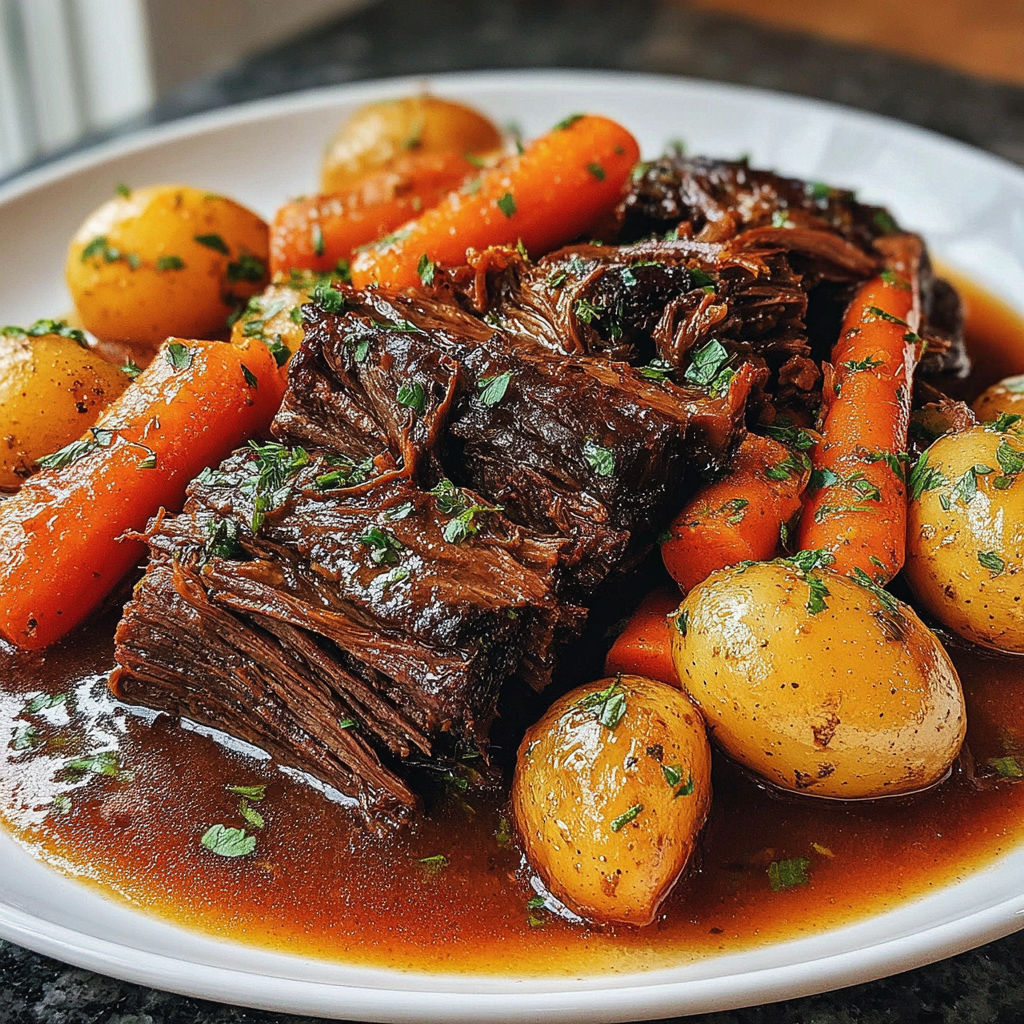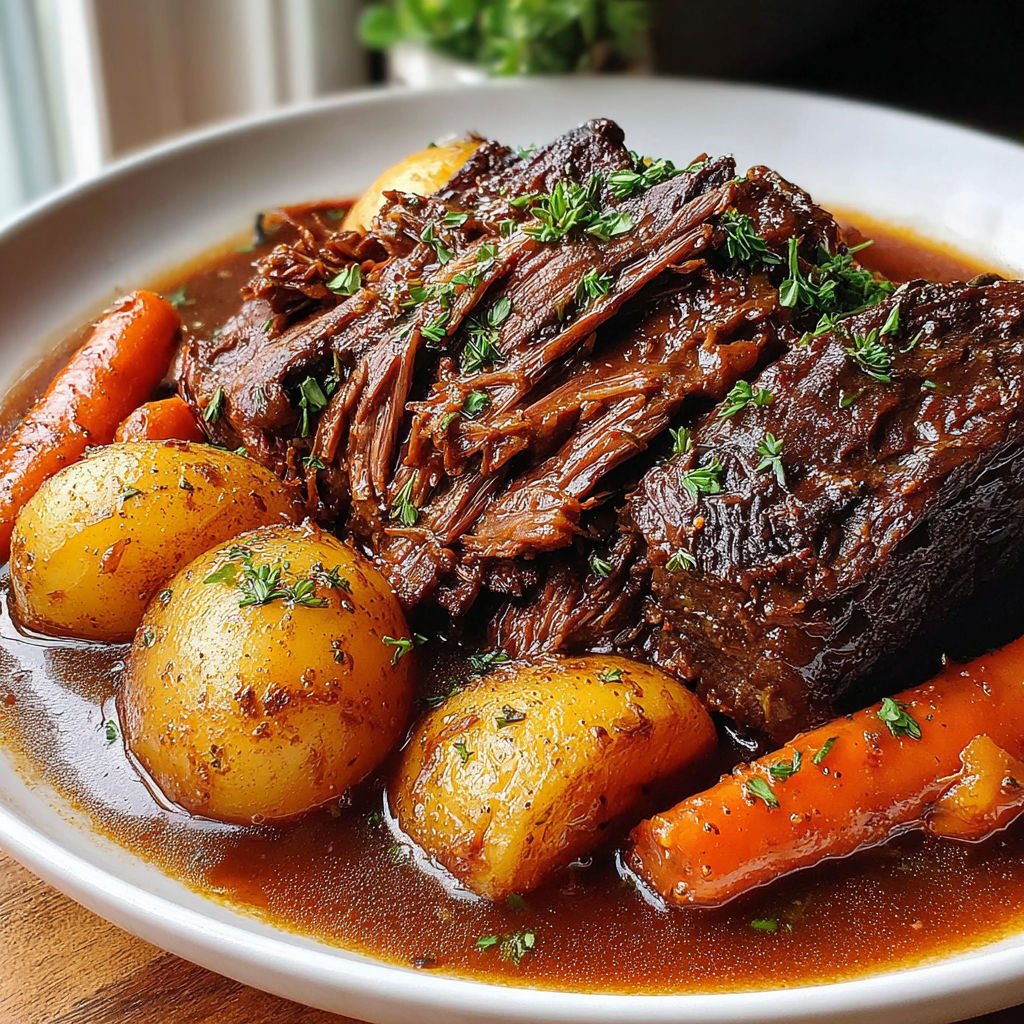 Save
Save
Pot roast slow cooker style is my answer to those chilly days when I crave something cozy but need dinner to basically cook itself. With minimal hands-on effort this recipe delivers fork-tender beef rich vegetables and the kind of savory aroma that makes the house feel extra warm.
I first tried this when my schedule was packed but I still wanted Sunday dinner perfection. Now it is a go-to every time I want guaranteed rave reviews with almost no fuss.
Ingredients
- Chuck roast: about three to four pounds Look for good marbling for tenderness and rich flavor
- Olive oil: A touch helps develop a beautiful sear and brings out the roast’s natural flavor
- Yellow onion, sliced: Brings sweetness and depth during long cooking
- Carrots, cut into hearty pieces: Choose firm carrots for best texture
- Gold potatoes, quartered: They hold shape well and soak up the broth’s flavor
- Fresh garlic, minced: Fresh garlic brightens up the entire dish
- Beef broth: Brings moisture and savory beef notes pick a low sodium variety if you like more control
- Worcestershire sauce: Boosts umami and gives a savory finish
- Salt and fresh cracked black pepper: Essential for seasoning the meat and veggies
- Dried thyme: Brings earthy herbal notes classic for pot roast
- Bay leaf: Adds gentle aroma and depth to the broth
Instructions
- Season the Roast:
- Rub both sides of the chuck roast with salt and black pepper making sure every surface gets attention. This is your chance to layer in flavor right from the start.
- Sear for a Flavorful Crust:
- Heat olive oil in a heavy skillet over medium-high. Sear the roast for about three minutes per side until deep golden brown. This develops the delicious crust that makes every bite worth savoring.
- Layer the Vegetables:
- Add your sliced onion carrots and gold potatoes to the bottom of your slow cooker forming an even layer. These will be the bed for the roast and soak up plenty of flavor as they cook.
- Add Aromatics and Seasonings:
- Scatter the minced garlic dried thyme and bay leaf over the vegetables. Pour in the Worcestershire sauce for added richness.
- Settle the Roast:
- Gently rest the seared roast atop the vegetables letting the juices drip over everything.
- Pour in the Broth:
- Slowly add beef broth around the sides of the roast so as not to wash away your seasoning. The broth will keep everything moist and infuse flavor into every bite.
- Low and Slow Cook:
- Put the lid on the slow cooker. For meltingly tender meat cook on low for about eight hours. If short on time high for four to five hours still does the trick but the longer cook always has my heart.
- Finishing Touches:
- Before serving remove the bay leaf then let the roast rest for at least ten minutes. This keeps the juices locked inside when you slice.

Every time I make this I am reminded of my grandma who believed a roast should always rest before slicing. The garlic is my favorite part because it provides that little pop in each bite
Storage Tips
Keep leftovers in airtight containers in your refrigerator for up to four days. Reheat gently in the microwave or on the stovetop with a splash of beef broth to keep everything moist. You can also freeze portions in freezer bags removing as much air as possible for up to three months.
Ingredient Substitutions
You can swap the gold potatoes for russets or sweet potatoes depending on what you have. For more veggies add parsnips or celery for extra texture. If chuck roast is hard to find brisket works but requires even longer cooking for tenderness.
Serving Suggestions
This pot roast pairs well with a chunk of crusty bread or spooned over creamy mashed potatoes. For a fresh bite serve with a side salad dressed simply with olive oil and lemon. Leftovers make amazing pot roast sandwiches or even get tucked into tacos.
Cultural and Historical Context
Pot roast has deep roots in American home cooking especially as a Sunday family meal meant to stretch a hearty cut of beef into something memorable. Slow cookers have changed how we make it today but the soul of the recipe is unchanged comfort patience and plenty of sharing.
Seasonal Adaptations
Use root vegetables like parsnip and rutabaga in the winter months. Try adding green beans or fresh peas towards the end of cooking in spring. Herbs like rosemary or sage can be swapped in for a different twist.
Success Stories
Friends have told me this was their first ever pot roast success because the recipe is so forgiving. Even novice cooks feel like pros with the help of the slow cooker. Nothing beats the smile when you lift the lid and see that fork tender roast after a long day.
Freezer Meal Conversion
Assemble all the ingredients raw then freeze in a large zip-top bag except the broth. Thaw overnight in the fridge add broth and pop it in the slow cooker in the morning. You get all day aroma and dinner with zero extra work.

Slow cooker pot roast with simple ingredients might become your new favorite cozy meal. The aroma alone is worth making it again and again.
Common Recipe Questions
- → How do I get a tender pot roast in a slow cooker?
Choose a well-marbled chuck roast and cook it low and slow with moisture. Sear the beef first to develop rich flavor, then let the slow cooker gently braise it until fork-tender—usually about 8 hours on low.
- → Can I substitute other vegetables?
Absolutely! Root vegetables like parsnips, turnips, or sweet potatoes work well. Just cut them into similar-sized pieces for even cooking alongside the beef and broth.
- → Do I need to sear the roast before slow cooking?
Searing locks in juices and deepens the overall flavor. It’s a recommended step but can be skipped for convenience—though the final dish benefits from the extra effort.
- → What is the benefit of adding Worcestershire sauce?
Worcestershire sauce enhances the savory umami profile, accentuating the beefy taste and adding complexity to the broth.
- → How can I store and reheat leftovers?
Cool leftovers promptly and store in airtight containers in the refrigerator for up to four days. For longer storage, freeze for up to three months. Reheat gently to maintain tenderness.
